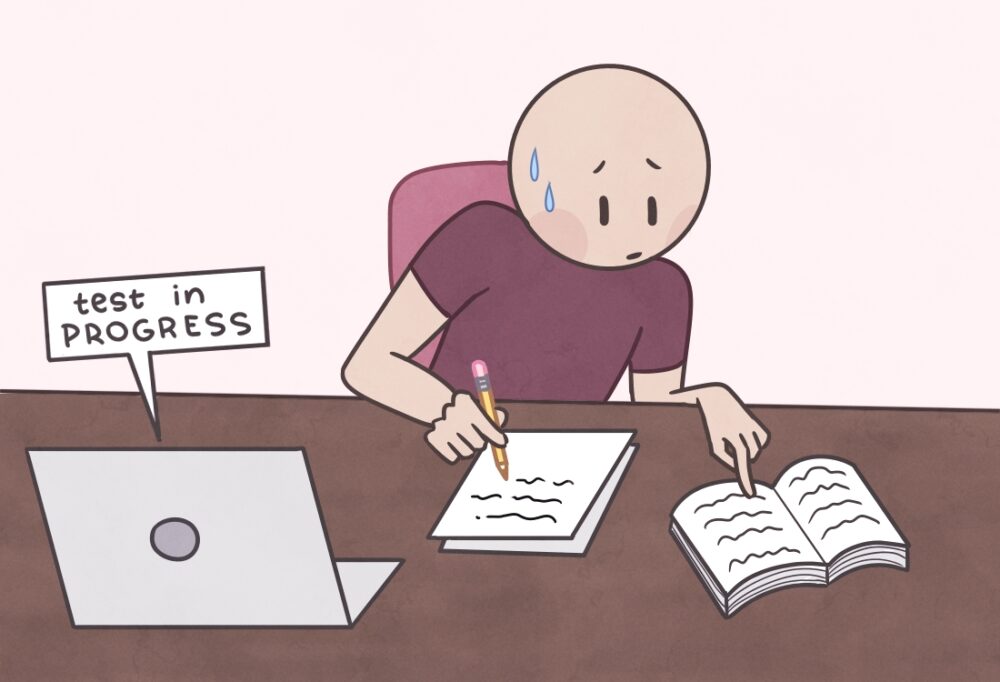
By Jessica Nguyen & Brian Pham
Cheating isn’t new among most students. Distance learning means there are even more opportunities to cheat, making it an even more serious concern for some teachers because they cannot monitor what their students are doing all the time.
Tools, such as cheat sheets or phones, can be hidden, so questions and answers are a simple click away. Students can also take tests or quizzes with the help of others through messaging or chat rooms.
“I feel like cheating on an assignment is something that humans usually experience at least once in their life,” biology teacher Erika Williams said. “It is usually a ‘fight or flight’ response-fear of failure-fear of running out of time-fear of working hard-that leads students down the path of inauthentic work.”
Despite the seemingly endless methods of cheating, teachers are working hard to maintain academic integrity within their classrooms.
Many teachers use Edulastic or Canvas for assessments. Both platforms require an access code when logging into tests and quizzes to ensure students are taking them within a specific time frame and aren’t looking at other tabs. Assessments are also taken under teacher supervision where students are asked to turn on their cameras so that they can be monitored.
For Canvas tests, many teachers take advantage of the platforms’ features to prevent cheating. One of the most common features is that teachers can choose to show one question at a time and lock questions after students have answered, forcing them to manage their time better. Thus, they are less likely to cheat due to the time constraint and are also unable to go back and change their answers.
Canvas allows teachers to see how much time students spend on a question as well. Having these monitoring options helps teachers determine whether or not a student has cheated.
Varied questions are another way to maintain academic integrity. Different formulas on Canvas input different questions on tests so that students cannot cheat off one another. Some teachers also have a bank of various short answer or essay exam prompts alongside different versions of tests.
Teachers can also mute test scores so that they cannot share answers and questions after students have taken the test. Some math and science teachers require students to turn in scratch work immediately after a test is over.
Some teachers, including Williams, have taken a step back from giving assessments and are focusing more on making “creative” assignments that require students to do the work themselves and are more “difficult… to blatantly cheat on.”
“I am implementing Flipgrid and other short video platforms that will give the students an opportunity to verbalize their knowledge with the support of using models to help explain their level of understanding,” Williams said.
Honor code violations can still be given during distance learning if students are caught cheating. Teachers expect students to learn the content of their course and maintain academic integrity.
“It’s impossible to catch every student who cheats-ultimately when you cheat-you’re cheating yourself from the experience of completing the assignment and actually learning something,” Williams said.
Many teachers share the same sentiment as Williams and want students to know they are there for support.
“I understand why some students cheat, but a better option would be to talk to your teacher,” English teacher David Theriault said.
He added that cheating doesn’t impact only the student cheating but also others around them.
“If you cheat in a class that has a curved grade, and you are driving down the score of students who didn’t cheat- that’s 100% not cool at all,” Theriault said. “I’ve seen students find out and lose respect for that student and their reputation stayed with them for a long time.”
Cheating is a long-existing problem in schools, and the reality is it will never stop. Despite this, teachers are doing their best to prevent cheating and hope that their students will get the most out of their class by doing authentic work.





